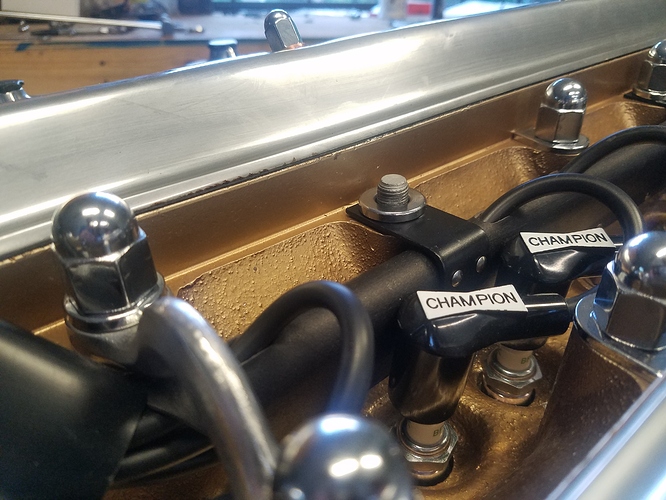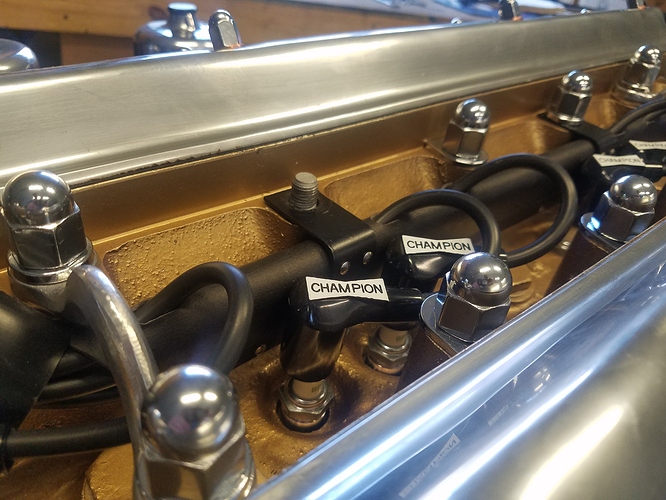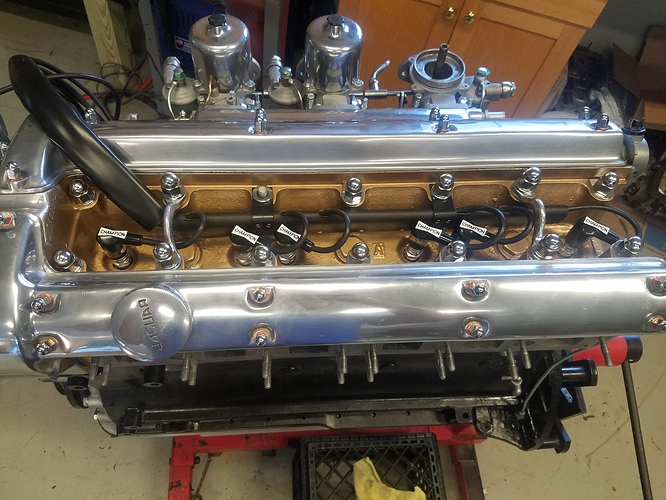Finally torquing down the head with a new gasket, new cylinder head studs and hardware. I had stepped up the torque and stripped out one of the nuts that sits on the lead strip mount metal before I got to 58 ft. lbs. I trust this is because It doesn’t have enough thread engagement. I plan to get a new nut and re-assemble without the washer. Is this common? Those nuts were a kit from Welch. Also, what is the torque on the small studs near the timing gear? Thank you!
The head studs are different lengths and must be located accordingly. There should be plenty of threads to prevent stripping the nut.
I would double check all the studs.
Marco
Found this from when I replaced mine. IIRC the stud with the blue tape has an area with a slightly larger OD for head/gasket alignment.
Never mind its the outside studs (new and old) that are used for alignment
I’m confused by the term “lead strip mount metal”…can you explain what you are referring to, or post a picture?
How much protruding thread did you have before you threaded on the acorn nuts? You’d have to have VERY little thread engagement to strip a proper head nut at below 58 ft-lbs.
I wonder if it’s possible the nuts supplied in your kit were not suitable for this purpose?
I believe Ben is referring to the spark plug lead conduit.
Marco
That’s what I thought as well.
Something’s wrong, the metal tabs holding the conduit ion place can’t be thicker than about 0.035".
The studs should be plenty long to allow for the conduit and washer.
Also, I did reference the diagram that illustrated the head studs but I’ll check the length again.
SI engine… ?
That conduit was missing on my car when I got it. I got a new one but I did not want to tempt fate by removing the acorn nuts to just to fit the brackets so I drilled out the rivets to remove the brackets. The conduit still sits pretty firmly in position without them and is not too noticeable that they have been removed . Just a thought in case you need an extra bit of the threads protruding from the head.
David
68 E-type FHC
When watching the last episode of ‘my junk e type engine’ on you tube, i noticed that he undid a couple of head nuts to fit the HT lead cover. Is that ok to undo torqued head nuts and refit?
Doesn’t it compromise the head gasket?
Phillip, there seems to be many types of head gaskets out there today, but often, back in the day, a new head gasket was to be retorqued after so many miles. To do that, one typically was to loosen the nut before retorqueing, so I do not see this as being any different. Possibly if the nuts had not been touched for many years, one may not wish to disturb them.
Tom
That’s a good idea. The nut did seem to be a super low grade steel. Not impressed. I think I’ll trim those mounting points on the lead strip cable organizer or even just drill them out to fit over the head of the nuts.
Same thing happened to me, brand new studs and nuts. The long 3.8 studs for use with the alloy hooks, with thick chrome washer on top left about 3/16" of threads visible. I think I ended up grinding down the thick washer. It’s been too many years to remember. It did not give me much confidence for hoisting using those hooks. That’s for sure.
Those middle studs look WAY too short to me. I would not use them like that…
Regards,
Ray L.
I agree with Ray that they look uncomfortably short, but I still don’t believe they should have stripped at such a low torque, if the stud and nut materials were correct.
The stud threads look damaged to me also.
I will measure the engagement and I think I may modify the spark plug lead sleeve mounting points a bit to reduce the stack up thickness. I may end up replacing the stud if there is damage. That nut was so soft I’m hoping the failure was only to the nut and the stud can just be cleaned with a tap.
If you compare an OEM nut and a new replacement chrome nut, there is much more thread depth on the old nut. I was tempted to get the old ones re-chromed, but have decided to try the new ones. Hopefully the engine will be running by this fall.
Generally speaking, thread engagement for studs should be 1.5 times the stud diameter. IIRC, those studs are 7/16", so 1.5 x .4375 = .65625"…between 5/8" and 11/16". This spec is for stud engagement into the block, which may not be achievable with dome nuts so I would measure the depth of the dome nut thread and go from there…you want as much as possible.
There may be some confusion, I am speaking of the % of thread engagement. Not the length of engagement. The manufacturer used a drill size, before threading too big to make tapping the nut easier. Typical thread engagement is 70% IIRC. The new nuts by my eyeball were only like 50%. Made in china???




